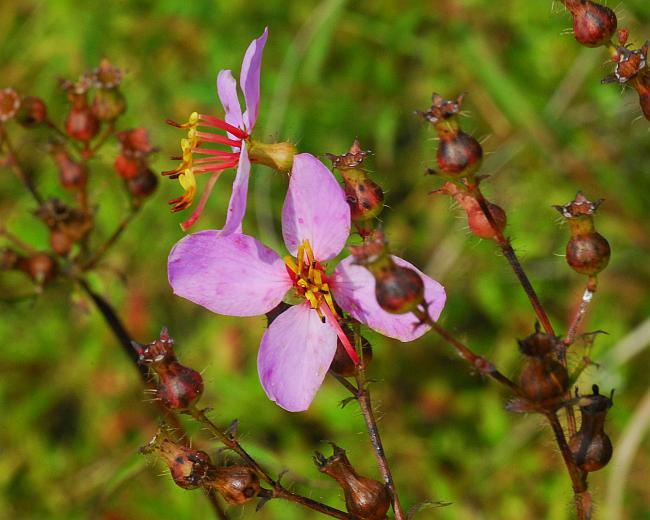Rhexia mariana L.
Meadow Beauty

Native
CC = Amb
CW = -5
MOC = 15
© SRTurner
Rhexia mariana L.Meadow Beauty | |
 |
Native CC = Amb CW = -5 MOC = 15 |
© SRTurner |
|
Family - Melastomataceae Habit - Rhizomatous perennial forb, sometimes woody at the base, these sometimes shallow and stolon-like. Stem - Ascending to erect, to 1 m, 4-angled, sometimes appearing nearly circular in cross-section, the angles not or inconspicuously winged, the wings less than 0.25 mm wide, sparsely to moderately glandular-hairy, especially at the nodes.
Leaves - Opposite, simple, sessile or short-petiolate. Blades 2-8 cm long, narrowly lanceolate to ovate, becoming narrowly lanceolate toward the stem tip, sharply pointed, glabrous or more commonly sparsely to moderately glandular-hairy, the margins sharply and finely toothed, the teeth often hair-tipped.
Inflorescences - Usually appearing as small panicles, with small loose clusters subtended by small leaflike bracts at the nodes (these often shed by fruiting).
Flowers - Perfect, with the perianth actinomorphic and the stamens and to some extent the pistil zygomorphic. Hypanthium tubular at flowering, persistent and becoming urn-shaped as the fruit matures, extended past the ovary as a short necklike tube, glabrous to moderately glandular-hairy. Calyces of 4 free lobelike sepals at the hypanthium tip, these 2-4 mm long, triangular, sharply pointed at the tip, persistent at fruiting. Corollas of 4 free petals, these 12-18 mm long, spreading, glabrous or nearly so, usually broadly obovate, rounded, pink to rose-purple. Stamens 8, strongly exserted at flowering, subequal in size, S-shaped and curved downward, the anthers 5-8 mm long, attached just above their bases, strongly curved outward, yellow, dehiscing by terminal pores. Pistil of 4 fused carpels, inferior (but often appearing superior at fruiting). Ovary 4-locular, the placentation axile. Style 1 per flower, somewhat curved downward, about as long as the stamens, the stigma depressed-capitate to somewhat disc-shaped, entire or nearly so. Ovules numerous.
Fruits - Capsules, urn-shaped with the neck usually longer than the body, 6-12 mm long. Seeds numerous, 0.4-0.7 mm long, flattened and spiral-shaped (snail-shell-shaped), the surface brown, with several concentric, spiral ridges along the sides and especially along the keel, these varying from smooth to warty or tubercled.
Flowering - June - October. Habitat - Sandy streambanks, depressions in sand prairies and sandstone glades, pond margins, forest openings, moist sandy disturbed areas. Origin - Native to the U.S. Lookalikes - R. virginica. Other info. - This attractive species is uncommon in Missouri, found in a few southern counties. Its range in North America is largely confined to the southeastern quadrant of the continental U.S., with some widely scattered populations as far north as Michigan and New York. The flowers of this species and its sibling (R. virginica) are unmistakable, with their long, yellow, banana-like anthers presenting an interesting visual contrast with the four pink petals. Photographs taken near Benton, Scott County, MO, 8-28-2015, and at the Edgar W. Schmidt Sand Prairie, Scott County, MO, 8-08-2022 (SRTurner). |